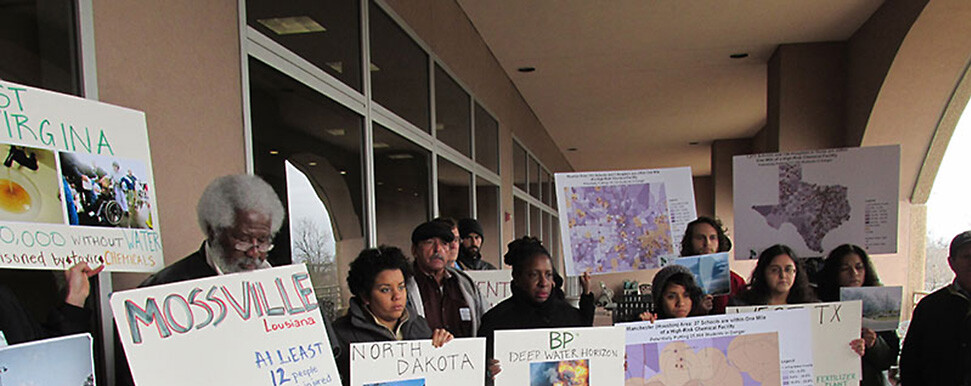
Media
December 7, 2021The Chemical Industry: An Overlooked Driver of the Climate Crisis, Says New Report
FOR IMMEDIATE RELEASE: December 7, 2021
CONTACT: Shayna Samuels, 718-541-4785, shayna@ripplestrategies.com
The Chemical Industry: An Overlooked Driver of the Climate Crisis, Says New Report
Over 100 Organizations Call for Transformation of Toxic Chemical Industry Toward Environmental and Climate Justice
(December 7, 2021) - A new report was released today about how the chemical industry is driving the climate crisis and what should be done about it. The new report - “The Chemical Industry: An Overlooked Driver of the Climate Crisis” - describes how chemicals and petrochemicals used to make plastic, rubber, fertilizers and more are made from fossil fuel feedstocks and manufactured using fossil-fuel based energy, accounting for roughly seven percent of global GHG emissions. Yet somehow the chemical industry is overlooked when it comes to climate solutions.
“We can’t solve the climate crisis without significantly reducing and replacing fossil fuels throughout the chemical industry,” said Darya Minovi, Policy Analyst at the Center for Progressive Reform, who authored the climate and chemicals report. “The chemical industry must do its part to stop our global temperatures from rising to the point of no return.”
Today’s report release was part of a larger call to action by over 100 organizations nationwide to fundamentally transform the chemical industry, coordinated by Coming Clean, a national environmental health and justice network. The newly-released Louisville Charter for Safer Chemicals is a roadmap for elected officials, businesses, labor organizers, scientists and concerned individuals to phase out persistent and cumulative chemical pollution.
The coalition released another policy paper today - “Addressing Environmental Injustice Through the Adoption of Cumulative Impacts Policies” - describing how low-income and communities of color are disproportionately impacted by toxic chemical pollution, and what can be done about it.
“The chemical industry has used its political and economic power to sacrifice the health and wellbeing of fenceline communities and their own employees in the name of profit for far too long,” said Michele Roberts, National Co-Coordinator of the Environmental Justice Health Alliance for Chemical Policy Reform, one of the signatories of the Charter. “Our priority is the protection of communities of color who live in the shadows of the polluting facilities, the workers who handle hazardous materials in fields and factories, and the Tribes/Indigenous communities whose ancestral lands, health, and way-of-life are continually at risk.”
According to the new chemicals and climate report, the chemical industry is driving the climate crisis in three primary ways: 1) Use of fossil fuels for energy production to manufacture chemicals; 2) Use of fossil fuels as feedstock for products such as plastics and pesticides; and 3) Production of chemicals that are potent greenhouse gases, such as HFCs (hydrofluorocarbons). By 2030, petrochemicals are set to account for more than a third of the growth in oil demand, and nearly half by 2050, ahead of freight, aviation, and shipping. This is largely due to a projected 40 percent increase in plastic production over the next decade, particularly in lower-income countries.
In addition, at least one-third of the most hazardous industrial facilities that use or store high-risk chemicals (almost 4,000 nationwide) face a growing risk of climate-induced natural disasters. Hotter temperatures also exacerbate the toxicity of air pollution and make chemicals in water and soil more likely to become airborne. The report calls for specific solutions, including: phasing out chemicals such as HFCs that in themselves contribute to climate change, stopping the expansion of plastic production, and eliminating the disproportionate burden of the petrochemical industry on fenceline communities.
Chemical and petrochemical operations are largely concentrated in low-income communities and communities of color, where people and families may already experience social and economic stressors that harm their health. In the event of a chemical disaster, these communities are hurt first and worst.
During the pandemic, people of color were nearly twice as likely to die from COVID-19 as compared to their white counterparts due to multiple factors, including disproportionate exposure to air pollution. Landfills, hazardous waste sites, lead poisoning, water contamination and climate change all affect communities of color and low-income communities across the nation. Today’s environmental justice report calls for solutions including: the adoption of cumulative impact policies in local, state and federal laws; and the adoption of laws that address long-standing racial discrimination that results in unjust environmental and health burdens in environmental justice communities.
“We can no longer eliminate one chemical at a time, only to have it replaced by another toxic substitute,” said Al Huang, Senior Policy & Legal Analyst at Coming Clean, a network of health, community, and environmental organizations working to phase out toxic chemicals. “We need to aggressively phase out classes of chemicals known to cause harm; invest in green chemistry and safer substitutes; and start requiring that chemicals introduced into the marketplace be fully vetted for health and safety.”
The Louisville Charter is named after an area in Kentucky with 11 industrial facilities that released millions of pounds of toxic air emissions every year, disproportionately impacting people of color. The full Charter and list of signatories can be seen here.
# # #
